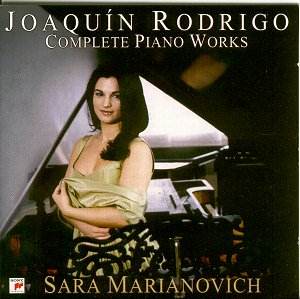On one hand there was the brilliant Iberia
of Albéniz, and on the other hand, the great French impressionist
piano of Debussy and Ravel ... I have tried to avoid Albéniz’s
piano style of accumulation by opposing it with one made by elimination".
Thus Joaquín Rodrigo who went on citing the example of Scarlatti
as an inspiring model for his piano music.
Rodrigo remained true to his ideals when writing for
piano, which he did for more than sixty years. The earliest work that
he acknowledges is his Suite para piano of 1923 whereas
his last piano piece Preludio de añoranza was composed
as late as 1987. The only work of his I can think of in which he side-stepped
his ideals is the Concierto heroico for piano and orchestra
which is in a quite different league. Otherwise, his many piano pieces
are short, colourful, tuneful miniatures of great charm but rarely attempting
gravitas and always deliberately eschewing any large-scale design.
His largest piano work, Sonatas de Castilla con toccata a modo
de pregón (1950/1), is more adequately described as a
suite of five short single-movement sonatas alla Scarlatti with
little attempt at musical unity through close thematic connections.
It would be idle to comment on every work recorded
here at any length for such is the risk of repeating oneself. Some pieces,
however, merit a few words. Rodrigo reworked some of his piano works
and some of them may be better-known in the reworked version. An example
of this is the beautifully nostalgic Zarabanda lejana
(1926), originally written for guitar, transcribed for piano and later
orchestrated for strings to become part of the much better-known Zarabanda
lejana y villancico. Another short piece worth mentioning is
Sonada de adiós (1935) written for the collective
homage to Rodrigo’s teacher Paul Dukas, for which Messiaen contributed
his Pièce pour le tombeau de Paul Dukas.
Old Spanish music often inspired Rodrigo. Thus Fantasia
para un gentilhombre for guitar and orchestra based on works
by Gaspar Sanz has its near-cousin here, Cinco piezas del Siglo
XVI (1938) in which pieces by de Cabezón, de Milán
and Mudarra are simply transcribed for piano, or Tres danzas de
España (1941).
Children also inspired Rodrigo. Think of his beautiful
orchestral work Cinco piezas infantiles (1924). Thus,
the delightful El album de Cecilia, "six pieces for
small hands", was written in 1948 for his daughter Cecilia whereas
the much later Danza de la amapola (1972) is dedicated
to his granddaughter.
Again, the bulk of Rodrigo’s piano music consists in
short pieces of great charm never outstaying their welcome, and there
is much to enjoy in this complete recording of his piano music.
Sara Marianovich has a long and close association with
Rodrigo’s piano music so that her readings obviously have the composer’s
nil obstat. In any case, she plays beautifully throughout and
this release is a delight from first to last, and should appeal to those
who keep asking : "Aranjuez, well, yes, but what else?" Here
is part of the answer.
Hubert Culot


